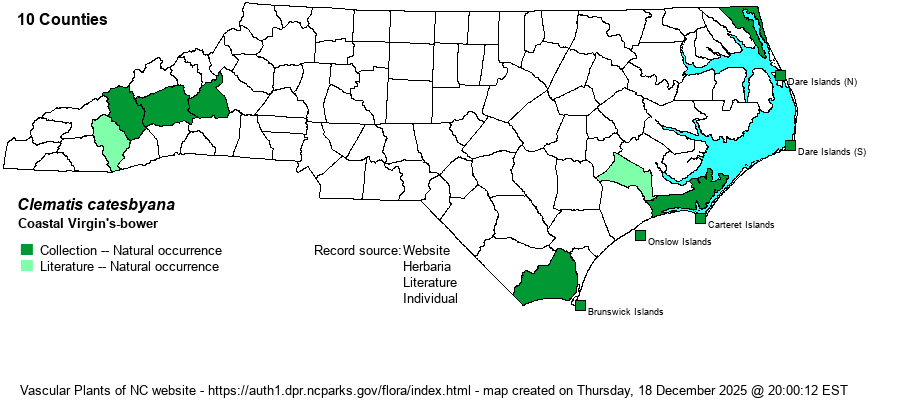| Author | Pursh | |
| Distribution | A highly disjunct range in the state, based on the very localized distribution of calcium-derived soils in NC. Mainly found along or very close to the coast, from the VA border to the SC border (in at least six of the eight such counties). Specimens at the NCU herbarium, from Buncombe, Haywood, and McDowell counties support the disjunct distribution in the Mountains, as does a Facebook set of photos from Jackson County in 2025. A sight report from Rutherford County (NCNHP database) and a specimen in the SERNEC database from Macon County seem to be in counties lacking the appropriate limestone/dolomite rocks for it to occur. At any rate, definitely present in a small area in the central Mountains.
This species has disjunct populations across its wide Southern range. It ranges from western VA and coastal NC south to central FL, and west to eastern KS and OK -- being absent over large portions of the range that lack limestone rocks.
| |
| Abundance | Rare to uncommon in coastal areas, and very rare and in a restricted habitat in the central Mountains. This is a Significantly Rare species, as assigned by the NCNHP. | |
| Habitat | This species grows in NC only over calcareous material. Along the coast, it occurs along the margins of maritime thickets and hammocks near shell material, in dunes and swales between and behind dunes, and on shell middens. Inland, it occurs on or next to exposed banks of dolomite rock, such as growing over shrubs and trees close to the rocks. | |
| Phenology | Blooms from June to September, and fruits shortly after flowering. | |
| Identification | This is a fairly long, sprawling vine, that can reach 10 feet or more in length, growing up into shrubs and trees. It looks quite similar to the quite common Virginia Virgin's-bower (C. virginiana). However, C. catesbyana has its numerous, opposite leaves with 3 to 7 leaflets, more often 5 leaflets (arranged pinnately), and these tend to be somewhat thicker or at least shiny as compared with the thinner and dull surfaces of C. virginiana. Both have somewhat broad serrations along the margins, as opposed to entire margins on the exotic, non-native C. terniflora. C. virginiana does not grow in coastal habitats, but both could occur in close proximity in the mountains. Each has numerous inflorescences, in axillary clusters, with 4-5 white sepals, each oblong in shape with a rounded tip, and the flower is about 1 inch across when fully open. There are numerous stamens/pistils that are also white. After flowering, each seed (achene) is attached to a feathery "plume", and these plumes create a "curlyhead" several inches across, hard to overlook! This species is best seen along the coast; look for a vine with typically 5 jagged leaflets, and either with 4-5 white "petals" or a curly ball of "fruit". You must be aware that the non-native C. terniflora can be found in some places near the coast (specimens from Brunswick County, and the BONAP map shows records for New Hanover and Dare counties), but it has smooth/entire margins to leaflets. | |
| Taxonomic Comments | The species was named in RAB (1968) as C. ligusticifolia, but Weakley (2018) says that name was misapplied. In fact, that old reference gave its habitats as "Low waste places", which is seemingly not correct for this species. Sure, the species does grow along sandy edges of maritime woods and shrub stands, but it seems uncertain if the authors were referring to this native species or to the non-native one, which in that reference was named as C. dioscoreifolia.
| |
| Other Common Name(s) | Satin-curls, Old-man's-beard | |
| State Rank | S2 | |
| Global Rank | G5 | |
| State Status | SR-P | |
| US Status | | |
| USACE-agcp | FAC link |
| USACE-emp | FAC link |

